Kim Hengen
Khengen@earthlink.net
Coalition School for Social Change
Global History, 9th grade
| About the Grant: |
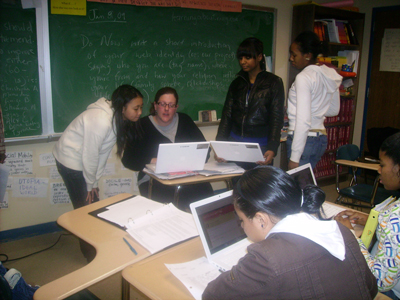
This project gives students the opportunity to look at various religions from different perspectives. In doing so, it makes this information more authentic. It also demands that the students
know the material and apply it in a creative way. As a class, students will explore several major world religions in depth using primarily internet resources. However, completing
this social networking project, they become not only mere recepticals of information, but invested learners. Furthermore, using a ning, it provides the students with a familiar format--a
social network--which they'll now transform into a learning experience.
learningabout.ning.com
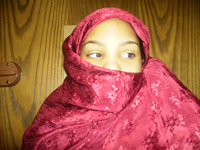 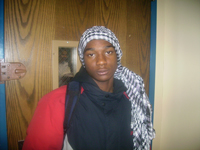 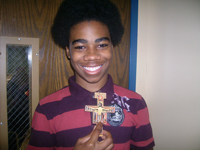
Hopefully by going indepth in an area of inquiry they become more invested and more motivated because of the learning that results. Much of our work is collaborative, hands on, and
inquiry-based. Virtually all culminating projects involve writing; I do not give tests. More and more I am incorporating technology into my classroom and this Ning project has
been one of a few technology-based projects we've completed that my students have really seemed to enjoy. |
| How This Grant was Adapted: |
The best aspect of this project is that it gives students the opportunity to look at various religions from different perspectives. In doing so, it makes this information
more authentic. They see it not as foreign, but come to empathize with the culture from where this religion is practiced. Furthermore, it also demands that the students know the material
well and gives them the opportunity to apply their knowledge in a creative way. Students will explore several major world religions in depth using primarily internet resources as they are
writing (in fact, they are encouraged and given extra credit to import relevant pictures, videos and textual references).
Hopefully by going indepth in an area of inquiry they become more invested and more motivated because of the learning that results. Much of our work is collaborative, hands on, and
inquiry-based. Virtually all culminating projects involve writing;I do not give tests. More and more I am incorporating technology into my classroom and this Ning project has
been one of a few technology-based projects we've completed that my students have really seemed to enjoy. |
| Project URL |
http://learningabout.ning.com
Student work is posted on this website. All lessons are below.
|
| Objectives |
Students will understand:
- The major features of Hinduism.
- Why the caste system persists today despite efforts to eradicate it.
- The key features of Buddhism.
- How Islam has been interpreted differently in various countries, especially in regard to women.
- The key features of Confucianism and how it encourages social harmony.
|
| Websites Used |
The 4 Noble Truths
http://thebigview.com/buddhism/fourtruths.html
Karma and Reincarnation
http://himalayanacademy.com/resources/pamphlets/KarmaReincarnation.html
What is Dharma?
http://sanskrit.org/www/Hindu%20Primer/dharma.html
What is Dharma?
http://hinduism.about.com/od/basics/a/dharma.htm
Purity vs. Pollution
http://codesign.scu.edu/hinduism/purity.htm
Links to current event articles:
Cops: Arson and Murder, by Way of India
http://cbsnews.com/stories/2008/01/03/national/main3669575.shtml
Brutal Attack in India Shows How Caste System Lives On
http://wsj-asia.com/pdf/opc_award/UNTOUCHABLE.pdf
Inter-caste Marriage Means Death for Haryana Couple
http://ibnlive.in.com/news/intercaste-marriage-means-death-for-haryana-couple/44704-3.html?from=search-relatedstories
India's Untouchables Face Violence, Discrimination
http://news.nationalgeographic.com/news/2003/06/0602_030602_untouchables.html
Caste System in Modern India
http://adaniel.tripod.com/modernindia.htm
Fable Entitled Prisoners of Karma":
http://accesstoinsight.org/lib/authors/karunaratna/bl125.html
An article about the 5 pillars of Islam
http://islam101.com/dawah/pillars.html
Taliban Treatment of Women
http://en.wikipedia.org/wiki/Taliban_treatment_of_women
Young Saudis, Vexed and Entranced by Love's Rules
http://nytimes.com/2008/05/12/world/middleeast/12saudi.html?
n=Top/News/World/Series/Generation%20Faithful&pagewanted=all
Stranger in Her Own City (video about a Yemen girl)
http://pangeaday.org/filmDetail.php?id=70
Headscarves and Secularism: Voices from Turkish Women"
http://gallup.com/poll/104257/Headscarves-Secularism-Voices-From-Turkish-Women.aspx
Life For Women in Iran, Beset by Fate, Culture
http://iranfocus.com/en/index.php?option=com_content&task=view&id=11268
Article on filial piety
http://casawomo.com/filialpiety.php
http://learningabout.ning.com
|
| Standards Addressed: |
History:
Students analyze evidence critically and demonstrate an understanding of how circumstances of time and place influence perspective.
Students examine the social/cultural, political, economic, and religious norms and values of Western and other world cultures.
Students explain the dynamics of cultural change and how interactions between and among cultures has affected various cultural groups throughout
the world.
Students analyze changing and competing interpretations of issues, events, and developments throughout world history.
Technology:
1. Creativity and Innovation Students demonstrate creative thinking, construct knowledge,
and develop innovative products and processes using technology. Students:
a. apply existing knowledge to generate new ideas, products, or processes.
c. use models and simulations to explore complex systems and issues.
2. Communication and Collaboration
Students use digital media and environments to communicate and work collaboratively, including at a distance, to support individual learning and contribute to the learning of others. Students:
a. interact, collaborate, and publish with peers, experts, or others employing a variety of digital environments and media.
Students use critical thinking skills to plan and conduct research, manage projects, solve problems, and make informed decisions using appropriate digital tools and resources. Students:
a. identify and define authentic problems and significant questions for investigation.
b. plan or manage activities to develop a solution or complete a project.
d. use multiple processess and diverse perspectives to explore alternative solutions. 5. Digital Citizenship Students understand human, cultural, and societal issues related to technology and practice legal and ethical behavior. Students: b. exhibit a positive attitude toward using technology that supports collaboration, learning and productivity. 6. Technology Operations and Concepts Students demonstrate a sound understanding of technology concepts, systems, and operations. Students: a. understand and use technology systems. b. select and use information systems effectively and productively.
4. Critical Thinking, Problem Solving, and Decision Making |
| Lesson 1: |
Lesson #1: Hinduism
Objective: students will understand the major features of Hinduism.
Materials: laptop and projector, various colored circle stickers, transparency paper
Introduction: define social mobility. Do we have social mobility in our society? Discuss in what ways we do as well as some ways
we don't. Tell students we will be learning about a religion that prevents social mobility.
1. Close reading (projected from laptop) of key concepts of Hinduism, including:
-
Dharma
-
Karma
-
Reincarnation
-
Caste
-
Enlightenment
Notes on laptop:
Caste: The station in life or level in society which one is born into. A group within society with has different rights, privileges
and duties from other groups. There are many castes prevalent in India. The highest of these is the Brahmans (the priestly caste), the Kshatriysa (the warriors), the Vaisyas (the merchants)
and the Shudras (servants). Those not belonging to a caste were social outcasts known as Pariahs or "Untouchables." Within each caste, or varna, there are
many subdivisions called jatis.
-
Brahmin (brah-min) A caste of high priests. The highest level of the Indian caste system. The Vedas (religious text)
were compiled and guarded by the Brahmins. They created complicated rituals and procedures for worship, prayer and sacrifice that required a Brahmin to perform and were well paid
for their services.
-
Kshatriyas (kshat-tre-yas) The warrior caste and noblemen. This caste is second below the Brahmins. The
future rulers of India were expected to come from this caste.
-
Vaisyas (vise-yas) Third in the caste system under the Brahmans and Kshatriyas. This caste contained the merchants,
skilled workers and farmers who provided all of India with food and products necessary for living.
-
Sudras (soo-dras) The fourth level of the caste system comprised of the servants and unskilled laborers.
-
Pariahs The workers not admitted into the four main castes, outcasts. Also referred to as "untouchables." They
are associated with unclean work such as scavengers, midwives, toilet cleaners, etc.
Dharma: the path in life to which your born. This includes the complex web of duties and obligations of your caste: who you can
marry or socialize with, what work you can do, what food you can or cannot eat, how to address others, and even how you walk out the front step of your home when you leave the house.
Karma: refers to the energy that is gained when one does not follow their dharma. This energy propels you, after death, into
another incarnation. The more karma you've gathered, the less likely you'll move up the caste system or escape it altogether and the more likely you will move
to a lower caste.
Enlightenment: a state of being one achieves after escaping the life cycle of life, death and rebirth; a state of peace; an end
to the suffering that defines life.
For additional information on these concepts to draw from, see the following sites:
The 4 Noble Truths http://thebigview.com/buddhism/fourtruths.html
Karma and Reincarnation http://himalayanacademy.com/resources/pamphlets/KarmaReincarnation.html
What is Dharma? http://sanskrit.org/www/Hindu%20Primer/dharma.html
What is Dharma? http://hinduism.about.com/od/basics/a/dharma.htm
2. Simulation: pass out colored circle stickers of various colors and put on students foreheads. Don't let the students
know what color they have on their forehead. Tell students that these will correspond to the various castes in the caste system and put the color code on the board. Tell them to mingle
and try to figure out what caste they're in. For example, everyone will flee from an untouchable, lest they get polluted; ask a Brahmin to eat with them; etc.
3. Debrief: How did it feel to be part of a certain caste and mixing with others? What could you tell about how this must operate
in real life? Lead students to understanding that it must be very confusing figuring out who is in which caste.
ASSESSMENT: teacher will debrief this lesson orally with students
to see if they understand how the caste system can be confusing (given the need to figure out one's caste status in relation to others) and demeaning.
Extension: to understand the interconnectedness of these concepts, have students read further about purity and pollution (see "Purity
vs. Pollution" http://codesign.scu.edu/hinduism/purity.html)
and, in pairs, create a visual diagram of Hinduism. In it they must show the key concepts of Hinduism as outlined in the previous lesson. It must also indicate movement. To this end,
students should begin with either a triangle, a ladder, or a spiraling line. Explain to them how these will help them show movement up and down the caste hierarchy.
|
| Lesson 2: |
Lesson #2: Hinduism
Objective: students will understand why the caste system persists today despite efforts to eradicate it.
Materials: online articles (see below)
Introduce lesson by asking students why they think the caste system continues even today in the 21st century despite
attempts by the government to eradicate it?
Jigsaw current event readings on the caste system by dividing the class into as many groups as there are readings and having
them become "experts" on that article. Students within these groups should support each other in doing this by taking notes together, checking for understanding,
and discussing.
Assessment: A quiz can be given on the material used for the jigsaw to assess whether or not students worked together to
take good notes, prepared thoroughly for 'teaching' and taught well--and to assess that those taught listened well and asked questions. However, I had a round table discussion where
students shared information that struck them the most from the shared materials, questions that persist for them, connections they made between this material and other things they've
learned in class, etc.
Links to current event articles:
Cops: Arson and Murder, by Way of India
http://cbsnews.com/stories/2008/01/03/national/main3669575.shtml
Brutal Attack in India Shows How Caste System Lives On
http://wsj-asia.com/pdf/opc_award/UNTOUCHABLE.pdf
Inter-caste Marriage Means Death for Haryana Couple
http://ibnlive.in.com/news/intercaste-marriage-means-death-for-haryana-couple/
44704-3.html?from=search-relatedstories
India's Untouchables Face Violence, Discrimination
http://news.nationalgeographic.com/news/2003/06/0602_030602_untouchables.html
Caste System in Modern India
http://adaniel.tripod.com/modernindia.htm
Next jigsaw class by rearranging groups so each new group contains one member of the former groups and have students "teach" their
information to their new groups. |
| Lesson 3: |
Lesson #3: Buddhism
Objective: to understand the key features of Buddhism.
Materials: online article (see below); large newsprint paper
Introduce Buddhism by asking students how might Hinduism be different if Enlightenment could be achieved in this lifetime. Lead
students to understand that the key difference between Hinduism and Buddhism is this and that this eliminates the caste system (in fact, Buddhism was a reaction to Hinduism).
Have students read fable "Prisoners of Karma" in preparation for this activity:
http://accesstoinsight.org/lib/authors/karunaratna/bl125.html
Have students, in pairs, create a visual representation of Buddhism using the characters in this fable. Encourage students to
identify the most salient points in this story to illustrate and figure out a way to incorporate them into one visual. Students can use thought or speech bubbles to help communicate these
points.
Put these visuals up around classroom with large newsprint paper next to each one. Have students do a â€~gallery walk' around
class and record their thinking about these visuals on large newsprint paper placed next to each one. They should also be encouraged to read each other's comments and respond
to these.
ASSESSMENT: the comments received during the gallery walk will allow students to assess each other (commenting on what was strong, what
was weak, how it could be improved, etc.). The visuals and the comments will also enable the teacher to assess this activity. Questions I consider when assessing the visuals
is whether they were able to incorporate all of the key aspects of Buddhism in a logical way into their visual representations.
After I developed the ning I realized that this assessment would have been even more effectively done had it been posted there. |
| Lesson 4 |
Lesson #4: Islam
Objective: to understand how Islam has been interpreted differently in various countries, especially in regard to women.
Materials: poster board, markers, notecards, online articles (see below)
Introduction: Ask students to share what they know about Islam and help students to identify the stereotypes and misinformation.
Tell students that several countries have Islamic governments that use the Koran to help inform their laws but that there are several interpretations of the Koran. Some predominately
Muslim countries choose to have a secular state.
1. Learn about the basic tenets of Islam by reading aloud together an article about the 5 pillars of Islam (see http://islam101.com/dawah/pillars.html).
Then assign one of the following links to students to explore:
Taliban Treatment of Women
http://en.wikipedia.org/wiki/Taliban_treatment_of_women
Young Saudis, Vexed and Entranced by Love's Rules
http://nytimes.com/2008/05/12/world/middleeast/12saudi.html?n=Top/
News/World/Series/Generation%20Faithful&pagewanted=all
Stranger in Her Own City (video about Yemen girl)
http://pangeaday.org/filmDetail.php?id=70
Headscarves and Secularism: Voices from Turkish Women"
http://gallup.com/poll/104257/Headscarves-Secularism-Voices-From-Turkish-Women.aspx
Life For Women in Iran, Beset by Fate, Culture
http://iranfocus.com/en/index.php?option=com_content&task=view&id=11268
2. After students have explored and taken notes on the assigned information have them come together with others who were assigned
the same information and prepare a short presentation. Presentations should include all the important information as well as a visual that helps to relay this information. They will be
graded on subject knowledge, organization and delivery. Review rubric together.
3. Students report to class by giving short presentations.
Note: this lesson will probably require at least 3 periods (1st period read article and finish for homework; 2nd period
come together in groups to prepare presentations; 3rd period give presentation)
ASSESSMENT: Students will be assessed on their presentations by way of a rubric which grades on Content Knowledge,
Organization, Presentation Skills, and Visual. |
| Lesson 5: |
Lesson #5: Confucianism
Objective: students will understand the key features of Confucianism and how it encourages social harmony.
Materials: transparency paper; online article (see below); large newsprint paper; markers; Dear Confucius letters (see
in "important documents")
Introduction: do you do everything your parents tell you to do without argument or complaint? Why or why not? Explain and give
examples.
Explain to students we will be exploring a philosophy today that is thought by those who follow it that it promotes social harmony.
1. By way of notes on transparency, explain the 5 main relationships of Confucianism to students and what is expected from each
partner. Introduce concept of filial piety.
Notes on transparency:
Confucius believed that there were 5 main relationships in life:
1) Father to Son
2) Elder brother to Younger brother
3) Husband to Wife
4) Ruler to Subject
5) Friend to Friend
He believed that all relationships were unequal:
However, he also believed that these relationships were reciprocal. He believed that to have an orderly
society, both people in a relationship had to follow their duties toward each other. These were:
One of his most important virtues of Confucianism is filial piety which is a loyalty that borders on religiosity. This is what
inferiors, especially children to their parents, were expected to show.
2. Silent Conversation on filial piety: scotch tape reading on filial piety (see http://casawomo.com/filialpiety.php)
to large newsprint paper and have students, in pairs, have a silent conversation with each other by responding to the reading on the newsprint paper. They can do this together at their
desks. After time is given to this have students debrief by having them share what struck them about the reading.
3. Ethical dilemmas: divide class into groups of three and hand out letters to Confucius (see attachment 2). Students will respond
to these letters with one of their own, using a Confucianist perspective.
ASSESSMENT: students will be assessed based on their responses to the Dear Confucius letters. The letters should demonstrate their
understanding of the 5 main relationships and filial piety, incorporating ideas on these appropriately and creatively.
Extension: have students type these up and send to teacher via email. Teacher compiles these all in a newsletter entitled "The
Confucian Times" and passes them out to class and school at large to showcase students' work.
|
| Lesson 6: |
Culminating Project: learningabout.ning.com
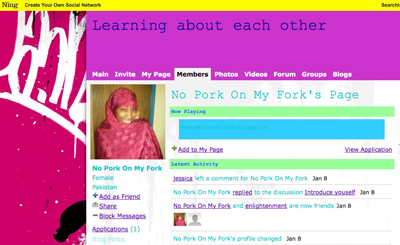
Objective: participating on this social network, students will gain understanding about the commonalties and differences
between the major world religions.
Objective: students will begin to appreciate and hopefully emphathize with people who are different from themselves.
Objective: students will gain a greater facility in navigating the web.
Objective: students will develop writing skills.
Using http://ning.com create
a myspace-like webpage. Each student is assigned one of the following identities: Hindu, Buddhist, Muslim, Confucianist, or Christian. Each student must assume these identities while
interacting with each other online. (Students who feel confident using the Christian perspective will be asked to do so. They will draw from their own knowledge as well as information
gotten from our comparisons in class to the Judeo-Christian perspective.)
After students have signed up on the page (they must be â€~invited" to join) students will post
pictures of themselves. To this end the teacher will provide props and take digital photos of students assuming their new identities .
Students will be instructed to do the following:
1. Introduce themselves in the persona of their religion, describing how their religion influences their lives.
2. Post ethical dilemmas (according to their traditions and customs) requesting advice from others. These should
be complex enough so that many "members" from different religions can respond to them in various ways.
3. Respond to other's dilemmas from their assigned perspective (at least 10 indepth responses). They may not
only give their unique perspective but argue the fine points of their religion with others who have been assigned the same religion (for those who find misinformation
or have different interpretations).
|
|
Kim Hengen has been a high school social studies teacher since 1995. Kim believes in project learning for students. She has been very involved in curriculum development for both schools and currently is the Curriculum Head for the history department.
WebpageRubric.doc
Project.doc
Dear_Confucius.doc
rubric_for_slam_presentations.doc
|